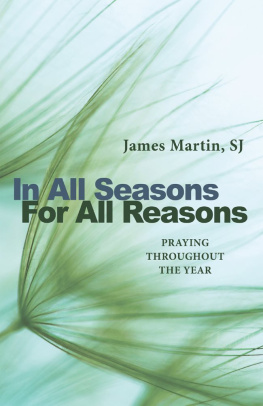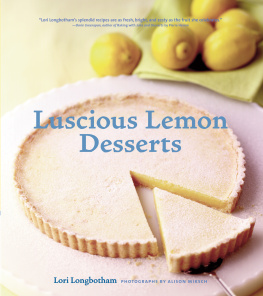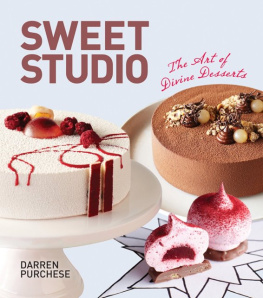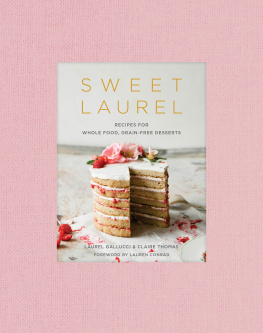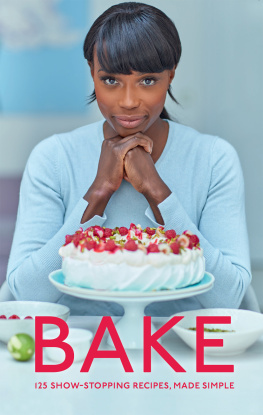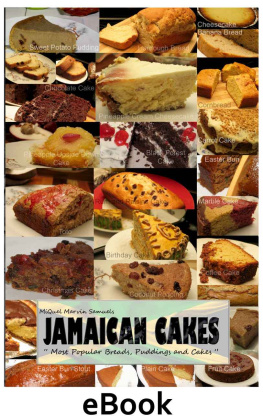



Publishing director: Sarah Lavelle
Publishing consultant: Jane OShea
Creative director: Helen Lewis
Project editor: Charlotte Coleman-Smith
Art direction & design: Gabriella Le Grazie
Photographer: Peter Cassidy
Food preparation and styling: James Martin,
Chris Start, Janet Brinkworth and Dave Birt
Props stylist: Iris Bromet
Production: Vincent Smith, Emily Noto
First published in 2015 by
Quadrille Publishing Limited
Paragon House
5254 Southwark Street
London SE1 1UN
www.quadrille.co.uk
Quadrille is an imprint of Hardie Grant
www.hardiegrant.com.au
Text 2015 James Martin
Photography 2015 Peter Cassidy
Design and layout 2015 Quadrille Publishing Limited
The rights of the author have been asserted.
All rights reserved. No part of this book may be reproduced, stored in a retrieval system or transmitted in any form or by any means, electronic, electrostatic, magnetic tape, mechanical, photocopying, recording or otherwise, without the prior permission in writing of the publisher.
Cataloguing in Publication Data: a catalogue record for this book is available from the British Library.
eISBN 9781849497374
CONTENTS

In my time, Ive been privileged to work in some of the best kitchens in the world, alongside some of the greatest chefs. Dont ask me how, as Id say its mostly been down to luck being in the right place at the right time. But I guess somewhere along the way you have to make your own luck, and of course you still have to produce the goods, as you do in any job.
For me, though, its not just a job. Its a life, and one that I will always love. Ever since I watched my grandparents making pastry in front of the old telly, rubbing butter into flour by hand, Ive wanted to cook; this, I suppose, was when the seed was first planted.
Nowadays, of course, the pastry bench is the place to be, with bake-offs all over the place. But it was a very different scene back in the early 1990s, when a young lad from Yorkshire entered the kitchens of some of the most well-known and well-respected chefs in the country. To say I was bricking it would be an understatement! Aged just 17, I quickly realised that there was going to be no shortcut to the top.
Pastry wasnt really what I had in mind at the time, but fate intervened: the pastry chef went to the loo, never to been seen again. And so after only three days I was on the pastry section, becoming head of it within four months. Back then, no-one wanted to work on the pastry section. To some, it wasnt seen as manly enough, for there was no heat and sweat and fire, but I reckon the real reason was the hours. As a pastry chef, you work longer shifts than anyone in the kitchen: there are early starts for the breakfast stuff, and you cant go home until the last table has ordered dessert. Not that it bothered me. In fact, it made me like it even more. I was on 90 a week, clocking up 115 hours most weeks, and I didnt know any different. What I did soon discover, though, was that when youre working with the best, you absorb everything like a sponge, and so all those hours paid off.
But its only when you sit down to write a book that you get chance to share all the recipes, tips and advice youve picked up along the way. Its now almost ten years since my first desserts cookbook came out, and Im really proud that its still in print and still going strong. Im especially thrilled when I hear of young chefs using it as a guide to baking and pastry.
With my next desserts book the one youre holding in your hands I wanted to take things further, to show how my cooking has evolved and how much I have learnt, and am still learning, from the great chefs Im lucky enough to meet. The rum baba is a case in point. There are good ones, and there are great ones, but for me the very best rum baba in the UK is Pierre Koffmanns. The recipe Ive included in this book is as close as Ive got so far, and I reckon its pretty close. It might even be close enough to save you the train fare to London to eat at his amazing restaurant, The Berkeley. Although, of course, its still worth making that journey for so many other reasons
I remember Pierre Koffmann telling me why chefs need to concentrate on the pastry section: not only is it the biggest section in the kitchen, but also its their dessert, or even just a petit four, which is the last food you taste before you leave the restaurant, so it needs to create a lasting impression.
Whilst I hope most things in here look impressive (and to be honest, its easier to make a cake look pretty than a duck leg), the taste must always come first. So what youll find in this book are the best of the best recipes Ive found, made up and borrowed, together with some basic recipes at the front and some handy troubleshooting tips at the back. Of course its not possible to show you everything to do with baking and pastry in one book, but it will point you in the right direction. The rest is up to you!
This is a book Im extremely proud of, and Ive done all I can to make it work on every level I even insisted on plating every single dish for the photography, which was all done at my house. I hope you enjoy it.



PROPER PUFF PASTRY

There are two types of puff pastry: rough puff and classic puff pastry. The differencelies in the way the butter is incorporated. In this classic recipe, a portion ofthe butter is added to the flour, salt and water to create a dough, which is thenlaminated with a large block of butter. The idea is to create layers between thebutter and the dough. When the butter melts in the oven it produces steam, whichis trapped between the layers of pastry, creating the puff. Its very importantto keep all the ingredients cold, even the flour. And always use butter, never margarine.You can store puff pastry in the fridge for 34 days, and it freezes very well.
Makes 550g
250g plain flour, plus extra for dusting
pinch of fine salt
300g cold unsalted butter (50g cut into cubes, the rest left in a block)
150ml cold water
Put the flour and salt on a marble worktop or in a bowl. Add the cubes of butterand rub together with your fingertips to form crumbs. Stir in the cold water andmix to form a soft dough. If using a bowl, tip out onto an unfloured work surface.Pat out into a 2cm-thick rectangle.
Next page

